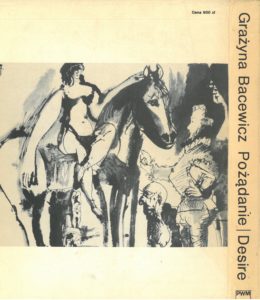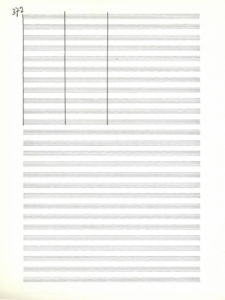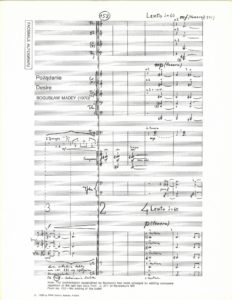- Desire, PWM score, cover
- Desire, PWM score, excerpt 1
- Desire, PWM score, excerpt 2
- Desire, PWM score, excerpt 3
- Desire, PWM score, last bars
- Desire, PWM score, Bogusław Madey’s reconstruction
I’m writing a full-evening ballet in honour of Picasso – with his knowledge and consent. The libretto is based on Picasso’s play, but we go far away from it. This rather uninteresting play is just a pretext. There will be a completely new piece. The plan: completely new things on stage and a new approach to dance. Working title: Desire.
This is the information given by Grażyna Bacewicz in a survey published in issue 7 of Ruch Muzyczny in 1969.
The man behind the idea to write the ballet was Mieczysław Bibrowski – a lawyer, journalist and great admirer of Picasso, who in issue 8 of Dialogue of 1967 published his own translation of Picasso’s only play, Le désir attrapé par la queue (Desire Caught by the Tail). The play was written over three nights, between 14 and 17 January 1941, which Picasso spent in his Parisian studio, having returned from Royan, where he had taken refuge after the outbreak of war. In Bibrowski’s view, the return to Paris in a situation when Picasso was included in the list of “degenerated artists” in Hitler’s Mein Kampf was an act of heroism on the part of the painter. The play is a partial settlement of scores with the author’s own conduct and overwhelming fear, feelings expressed in a unique way – in the poetics of surrealism, a literary movement with which the painter had been associated for many years, for example, as the author of the first issue of Minotaure, a magazine of the surrealists published in 1933. The characters appearing in the play are allegorical: the Big Foot is the author’s alter ego, the Tart personifies the women in his life, while the Cousin is France, Picasso’s second homeland. Worthy of note among the other characters are Fat Anguish and Skinny Anguish, allegories of fear. The desire indicated in the title occurs on many levels – the first is the most biological dimension of this attribute of human nature, depicted in the relationship between the Big Foot and the Tart, for example. The omnipresent hunger affecting occupied Paris produced an extraordinary desire for food, hence the abundance of culinary metaphors in the play. The Anguishes desire victims. There is a desire for ordinary life revealed in the protagonists’ search for a villa in which they could hide their concerns. But the Big Foot warns: “Do not hide so skilfully behind the arse of history, which interests and worries us so much.” Picasso must have been trying to resolve his own dilemmas, which he expressed in the final apotheosis of victory symbolised by a large golden boule rolling on to the stage and “acquitting” everybody who might feel guilty for any reason.
The play was premiered privately in March 1944 in the apartment of Michel Leiris – an ethnographer, surrealist poet and novelist. The director was Albert Camus and the performers featured Simone de Beauvoir, Jean-Paul Sartre and Dora Maar. After the war the play was presented at several venues in Europe and then Picasso’s growing fame as a painter overshadowed his debut as a playwright.
In his article “Picasso the playwright”, published in the same issue as the text of the play, Bibrowski mentioned Francis Poulenc, who composed an opera to Apollinaire’s play Les Mamelles de Tirésias (The Breasts of Tiresias).
Would it not be worth celebrating the 85th anniversary of the great artist in a similar fashion, by returning in one way or another to his set designs and literary oeuvre?,
he asked and then turned his words into action, asking Jerzy Jasieński, the then director of Warsaw’s Teatr Wielki, to commission a ballet to a libretto after Picasso’s play. Jasieński approached Grażyna Bacewicz, who accepted the commission. The collaboration between Bibrowski, the author of the libretto, and the composer was not easy. The librettist and script writer decided to modernise the “content” of the ballet by adding new elements “in the spirit of the period”. In addition to Fat Anguish, symbolising a highly developed part of the world, and Skinny Anguish, representing “the excluded”, there emerged Atomic Anguish into which Fat Anguish was transformed. Dance numbers were intended as illustrations of various aspects of modern life: fear of nuclear war as well as joy relating to the conquest of space. Novelty was to have included constructions remotely controlled by an electronic machine (1968!) and dancing with humans, evolutions on the trapeze and on the line as well as catapults launching acrobats, all of which was intended to express the precarious balance in which the modern world found itself. A modern Golem myth appeared as well, presented in the fight between humans and machines in the Cybernetic Ballet. The eight part production proposed by Bibrowski was to have included a dance of mechanical doves of peace and mechanical hawks, rockets rising and falling, and, finally, a new dance, Picassienne, as a tribute to the great artist and through him – to free, unfettered creation.
Appreciating the efforts of the librettist seeking to create a truly modern ballet, which would feature technological achievements and fundamental questions of the contemporary world, Grażyna Bacewicz slightly reformed his idea, thanks to which she was able to tone down the ideological message of the script. In its final version the ballet comprises two acts divided into scenes. They are:
Act I
- Prologue. Picnic – Storm. Curtain. Danse macabre
- Skinny Anguish and Fat Anguish
- Atomic Anguish
Act II
- Love game
- Ballet of the innocents
- Cybernetic ballet: Dance around the Machine. Dance of the Machine (Construction). Machine. Machine and people now in harmony.
- Remotely controlled air ballet
- La Picassienne I
- La Picassienne II
The ballet was written with the knowledge and consent of Picasso, who, however, refused to design the sets. Therefore, we do not know what might have been meant by the remark included in the score (no. 3): “Picasso’s curtain appears”. Did the composer include that remark before the painter’s final decision?
In her music Grażyna Bacewicz distanced herself from any temptation to interpret the action on stage through musical means, opting instead for grotesque or comic exaggeration, yet drawing on tradition in some way as well, by using leitmotifs. Leaping ninths of the first violins against a background provided by a “bombastic” prologue (tam-tam, timpani, standing note of the wind instruments, strings, percussive piano, vibraphone, celesta, thunder sheet) make up the Big Foot theme. The motif is contrasted with a cantabile of the flute and the oboe in no. 3 (Tart motif) and an oboe line taken straight from Dialogo, the second movement of Musica sinfonica in tre movimenti. There are also leitmotifs for the Anguishes. Desire is full of self-quotations, which obviously provokes questions about their purpose. Was the reason only the haste associated with an approaching deadline, trip to Armenia or perhaps a vague feeling that her health was deteriorating? Analysing the “patchwork” method also in the composer’s other works, Adrian Thomas [Adrian Thomas, “Self-Quotation in the Music of Grażyna Bacewicz”, Poznań 1998] suggests that some self-quotations, like the Intermezzo theme from Partita opening Act II of Desire may have been iconic for the composer, constituting a totem, as it were. The self-quotations may have been a refuge in a familiar world, in preparation for a journey in search of new sound worlds, a journey that never happened.
However, Desire does contain some innovations relating to the nature of the piece. The composer agreed to retain and record some sentences from Picasso’s play, which were to be played from loudspeakers placed around the room, to record sound effects (for example, children’s shouts of “Hop! hop!” and crying to be used in the Ballet of the innocents) or to juxtapose instruments recorded on tape with a live orchestra, as in the Remotely controlled air ballet. The storm scene in Act I contains aleatory sections; the musicians play while giggles recorded on tape are heard in the background. There are more aleatory sections, also in Act II.
In order to depict various situations on stage, the composer uses a whole range of colours of various instruments – from playing in extreme registers, through the use of all kinds of articulation techniques (for example, string instruments treated as percussion instruments, playing behind the bridge) to unusual instrumental line-ups with a large share of the percussion and a narrative which can easily be compared to the montage technique. The ballet remained unfinished. Notes left by the composer suggest that there was still five more minutes of music to be written to complete the score. The golden boule from Picasso’s play was to have been illustrated by the note C sharp growing in volume (“I associate C sharp with gold,” wrote the composer). The notation ends in the middle of a fragment entitled La Picassienne or, in fact, what precedes it – a fragment in which we can hear farewells played from tape. The score was completed by Bogusław Madey, but despite attempts to draw on Grażyna Bacewicz’s style, his music is an alien element. That is why it was not included in the first production of the ballet, premiered on 18 March 1973 at Warsaw’s Teatr Wielki and featuring a choreographic concept by Jerzy Makarowski and sets designed by Andrzej Majewski. The orchestra was conducted by Mieczysław Nowakowski. The use of tape was abandoned and the whole was limited to one act, without staging ideas suggested by Bibrowski and the composer herself, but with the “content” of the ballet being limited to timeless topics like eroticism or anguish.
It is true that the libretto of the ballet with its ideological message sounds outdated today, although some problems represented by the Anguishes remain unchanged; they have even become more urgent. Technological progress and development of multimedia open up new possibilities for staging the ideas included in the script and the score. Thus Bacewicz’s and Bibrowski’s Desire is still waiting for a visionary who will breathe new life into the work, currently frozen on paper.





